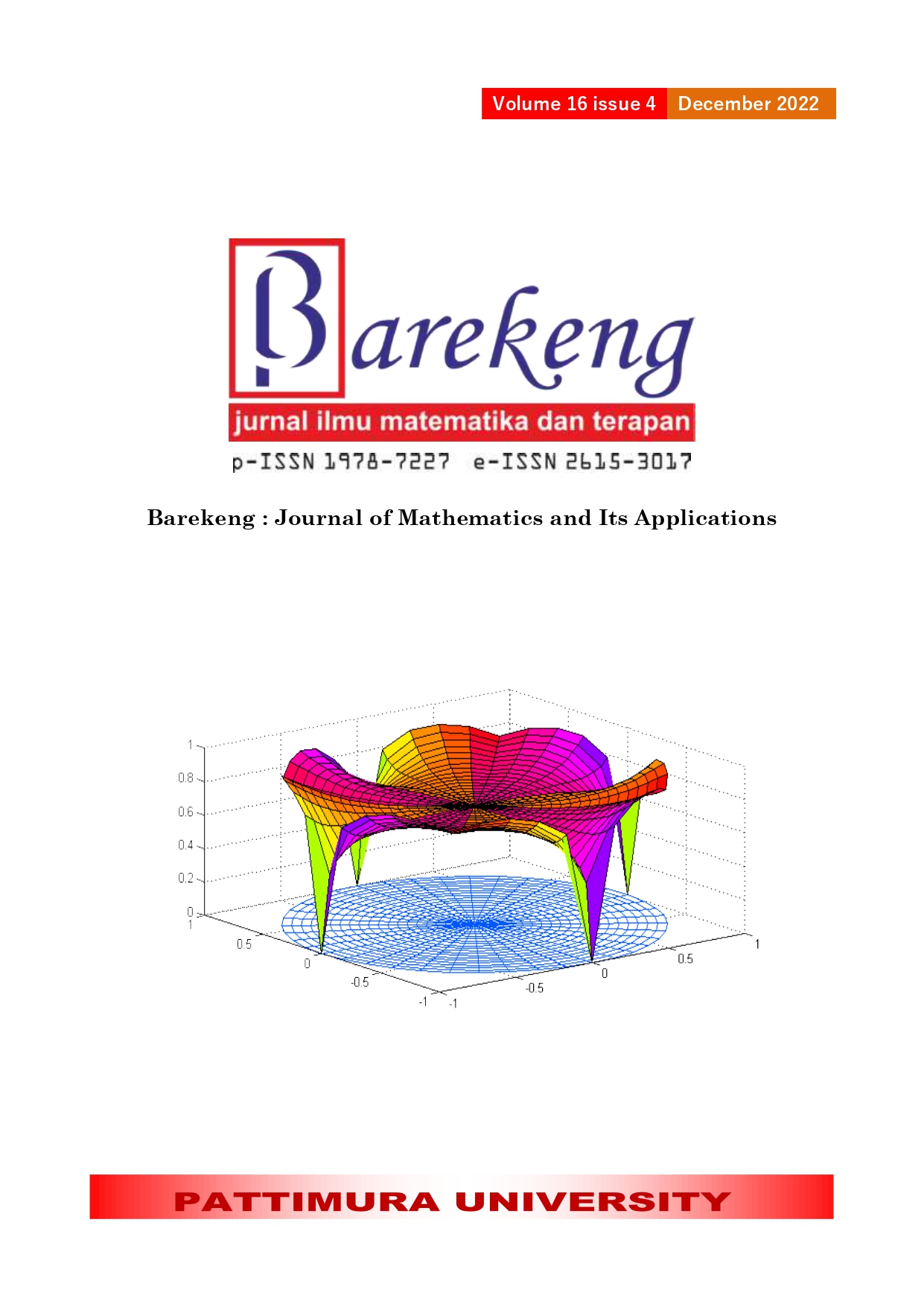MATHEMATICAL SILVER FOR ENTREPRENEURIAL MATHEMATICS
Abstract
This article shows the result of entrepreneur mathematics by creating mathematical objects from silver. The objects discussed here are accessories to introduce undergraduate students to integrating several aspects of learning mathematics. These are learning geometry modernly, mathematical art, popularizing mathematics for society, introducing entrepreneurial values using mathematics, teamwork for achieving targets, and considering local heritage in mathematics. These aspects are blended into activity by creating designs and producing products based on the obtained designs. The particular product for this activity is creating silver accessories. The used research method is initiated by creating designs with the help of software where the surface equations are known. After the designs are obtained, the designs are communicated to the silver craftsman to be a partner in design testing and manufacturing of accessories products using the given designs. The size and the similarity of perceptions to the appearance of the design are discussed because the actual design is a three-dimensional image but expressed in objects to be two- dimensional objects. After productions are obtained, the accessories are managed to be promoted to the marketplace and social media as a form of entrepreneurial activity with materials starting from mathematics.
Downloads
References
N. Akhter and N. Akhter, “Learning in Mathematics: Difficulties and Perceptions of Students,” J. Educ. Res., vol. 21, no. 1, pp. 147–163, 2018.
A. A. Genlott and Å. Grönlund, “Closing the gaps - Improving literacy and mathematics by ict-enhanced collaboration,” Comput. Educ., vol. 99, pp. 68–80, 2016, doi: 10.1016/j.compedu.2016.04.004.
Christine K. Pritchard and John H. Lamb, “Teaching Geometry to Visually Impaired Students,” Math. Teach., vol. 106, no. 1, p. 22, 2012, doi: 10.5951/mathteacher.106.1.0022.
N. Baya’a and W. Daher, “Mathematics teachers’ readiness to integrate ICT in the classroom,” Int. J. Emerg. Technol. Learn., vol. 8, no. 1, pp. 46–52, 2013, doi: 10.3991/ijet.v8i1.2386.
L. Colette, “Teaching and Learning Geometry,” in The Proceedings of the 12th International Congress on Mathematical Education. Springer, Cham., 2015, pp. 431–436. [Online]. Available: https://doi.org/10.1007/978-3-319-12688-3_35
G. Kospentaris, S. Vosniadou, S. Kazi, and E. Thanou, “Visual and Analytic Strategies in Geometry,” Front. Learn. Res., vol. 4, no. 1, pp. 40–57, 2016, doi: 10.14786/flr.v4i1.226.
H. Serin, “Perspectives on the Teaching of Geometry: Teaching and Learning Methods,” J. Educ. Train., vol. 5, no. 1, p. 1, 2018, doi: 10.5296/jet.v5i1.12115.
M. Lévesque, “Mathematics, theory, and entrepreneurship,” J. Bus. Ventur., vol. 19, no. 5, pp. 743–765, 2004, doi: 10.1016/S0883-9026(03)00028-4.
V. Bikse and I. Riemere, “The Development of Entrepreneurial Competences for Students of Mathematics and the Science Subjects: The Latvian Experience,” in Procedia - Social and Behavioral Sciences, 2013, vol. 82, pp. 511–519. doi: 10.1016/j.sbspro.2013.06.301.
O. Mary Olukemi and O. Ezekiel Gbenga, “Relevance of Mathematics Education to Entrepreneurship Skills Acquisition towards the Realization of Vision 20:2020,” Int. J. Cross-Disciplinary Subj. Educ., vol. 7, no. 2, pp. 2768–2773, 2015, doi: 10.20533/ijcdse.2042.6364.2016.0377.
H. Palmér and M. Johansson, “Combining entrepreneurship and mathematics in primary school–what happens?,” Educ. Inq., vol. 9, no. 4, pp. 331–346, 2018, doi: 10.1080/20004508.2018.1461497.
F. O. Haara, “Pedagogical Entrepreneurship in School Mathematics: An Approach for Students’ Development of Mathematical Literacy.,” Int. J. Math. Teach. Learn., vol. 19, no. 2, pp. 253–268, 2018.
R. A. F. Palácios, L. S. Paz Montes, and D. M. Alvarez Paz, “Mathematical entrepreneurship in educational institutions,” in Journal of Physics: Conference Series, 2019, vol. 1408, no. 1. doi: 10.1088/1742-6596/1408/1/012019.
H. A. Parhusip and B. Susanto, “Inovasi Geometri sebagai Media Pembelajaran Matematika Kreatif,” J. Mat. Kreat., vol. 9, no. 1, pp. 63–70, 2018, doi: https://doi.org/10.15294/kreano.v9i1.14047.
H. A. Parhusip, “Efek Diskritisasi pada Modifikasi Hypocycloid Menjadi CSCPP (Curve Stitching Connected Pseudo Polygon),” Jambura J. Math., vol. 2, no. 2, pp. 60–72, 2020, doi: 10.34312/jjom.v2i2.4385.
M.-B. Alexandrescu and M. Milandru, “Promotion as a form of Communication of the Marketing Strategy,” L. Forces Acad. Rev., vol. 23, no. 4, pp. 268–274, 2018, doi: 10.2478/raft-2018-0033.
I. B. & Odunlami and E. T. Akinruwa, “Effect of Promotion on Product Awareness (A Case Study of A Reputable Organization in the Brewery Sub-Sector of the Manufacturing Industry),” Int. J. Educ. Res., vol. 2, no. 9, pp. 451–472, 2014, [Online]. Available: www.ijern.com
Copyright (c) 2022 Hanna Arini Parhusip, Didit Budi Nugroho, Hindriyanto Dwi Purnomo, Istiarsi Saptuti Sri Kawuryan

This work is licensed under a Creative Commons Attribution-ShareAlike 4.0 International License.
Authors who publish with this Journal agree to the following terms:
- Author retain copyright and grant the journal right of first publication with the work simultaneously licensed under a creative commons attribution license that allow others to share the work within an acknowledgement of the work’s authorship and initial publication of this journal.
- Authors are able to enter into separate, additional contractual arrangement for the non-exclusive distribution of the journal’s published version of the work (e.g. acknowledgement of its initial publication in this journal).
- Authors are permitted and encouraged to post their work online (e.g. in institutional repositories or on their websites) prior to and during the submission process, as it can lead to productive exchanges, as well as earlier and greater citation of published works.






1.gif)



